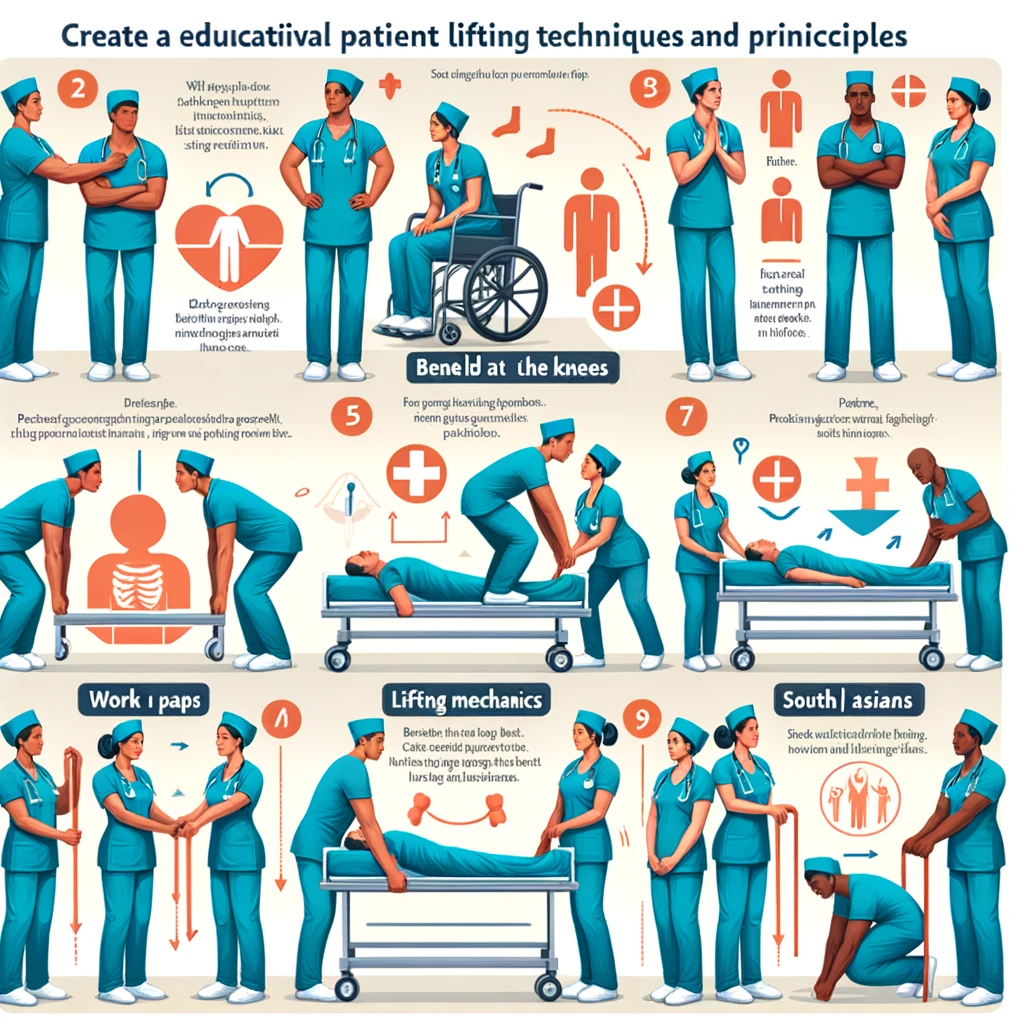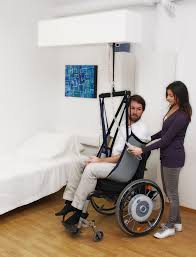Proper Patient Lifting Techniques And Principles are discussed in this article. This guideline will be very informative for nurses. Professional nurses must practice these techniques.
General Principles
- A cardiac patient in Intensive care unit should only he moved with advise of doctor.
- A very ill patient with low pulse or blood pressure should be moved without the patient’s help.
- Very ill patients should be moved as little as possible.
- While moving or lifting a patient you should avoid bending your back. Draw the patient to the side of (he bed and bend your knees slightly.
Lifting a Patient’s Hip
- Have patient flex knees with feet flat on bed.
- Place your hand under sacrum to raise hips.
- Ask the patient to raise hips and bear his weight slightly upon his feet.
- Two or more nursing staffs are required for an invalid, or obese patient.
- Care should be taken while moving or lifting a hip of a patient having any disease of hip-joint or pelvis area.
Lifting Patient’s Head and Shoulders
- Raise head of the patient with one hand.
- Bend your arm slightly, pass it behind patient, place hand under his far shoulder, fingers in axilla. The neck of patient should rest in bend of your elbow.
Moving Patient to One Side of Bed
One Nurse : Pass one arm under patient’s neck and shoulder, the other under upper part of thigh and draw him towards you.
TWo Nurses : One nurse supports head and shoulders with one arm and slips other arm under small of back.
Second nurse slips one arm under back beside that of the other and the other arm under the thighs.
Nurse may stand on the same side of bed or on opposite side. Turning Patient on his Side.
Turning Patient On His Side
Method : I—1. Cross patient’s legs. 2. Slip left arm over his far shoulder to turn patient towards you. 3. Slip other arm over his far hip, raise him slightly and turn him towards you. Keep pillow underbid head.
Method: II—1. Cross patients, legs. 2. To turn patient you slip one arm under patients arm from near side. Have hand come well round opposite thigh 3. Raise patient slightly, pull left hip towards you turning him at the same time. 4. Adjust position if necessary and support back pillows.
Every Nurse Must Know Proper Patient Lifting Techniques.

Lifting Patient up on Pillow
- Ask the patient to flex his knees.
- Pass left arm under patient’s neck and shoulder.
- Pass other arm under upper part of thigh and knees.
- Have the patient put hands on bed, palms down and slightly bear his weight on hands and push up with his feet. Make sure that your lifting corresponds with his pushing.
- If the patient is unable to help himself two nurses are required. They should proceed, as in moving patient to one side of bed. The patient may put his hands on the shoulders of nurses for support with hands on their far shoulders.
Changing of Pillows
Ts remove pillows : Slip one arm under patient’s neck and far shoulder allowing his head rest on your arm. Raise slightly and with free hand, remove pillows, pulling them out towards you.
Ts replace pillows : Shake pillows well. Put within easy reach of bed on far side. Raise patient as above and with free hand. Draw pillows back towards you into place.
Close Gown Or Close Nightgown
Open Gown : 1. Remove one sleeve. 2. Pass your hand through the bottom of the corresponding sleeve of fresh gown and grasp patient’s hand, dressing arm down through sleeve. 3. Slip fresh across chest under soiled ono and repeat the procedure. Use some method in reverse if gown opens in front turning the patient on one side.
Closed Gown or closed shirt
- Bring the patient to lie on back with knee flexed.
- Let the patient raise his hips slightly pull gown up as far as possible.let the patient raise his back slightly and draw gown up round neck.
- Slip your right hand from below through the upper arm hole of the right sleeves, grasp elbow and remove sleeve.
- Slip gown over his head off other arm.
Putting clean gown
He procedure can be practiced in the same manner as soiled one reversing the order of the procedure.
Method of Changing Mattress for Bed Patient
- Care should be taken for moving the patient from physician for cardiac patient or for patient with illness.
- The patient should be informed about the procedure.
- Place both blankets over patient and remove upper clothes.
- Place stretcher along side of the bed and with the tariff two nurses or more draw patient into it. You may patient with help of draw sheet or dari.
- Change mattress and re-make foundation.
- Move patient from stretcher to fresh bed and replace d bedding.
- A severely ill patient should not be allowed to move alone.
Method of Carrying Patient from a Bed to a Stretcher
This procedure requires help of other persons, may be staff.
Fold top bedding to the foot while covering the patient a bath blanket.
Method: I
- Place stretcher at right angle to the bed with head stretcher to foot of the bed.
- All persons should stand on same side of bed. Patient well under patient to support head and entire body.
- All persons should lift the patient together in one swing half way round, bring head to foot of bed and place patient gently on stretcher.
Method: II
- Place stretcher parallel to bed.
- Four persons are required for this method. One starlit the opposite side of the bed. Three will have to reach an the stretcher. The persons at the head and the foot of the stretcher may find it easier to step around the end all stretcher.
- Grasp sheet beneath patient and support shoulders and ‘ separately.
- Co-ordinate lifting and swing patient to stretcher by pulling the .sheet and patient towards stretcher quickly and gently.
- The sheet can be removed at this time by turning patient from side to side. Or wait until the patient has been transferred from the stretcher to the bed or table again.
- The opposite method is used when moving a patient from the stretcher to the bed.
Practical Tips for Patient Lifting Techniques
- Always seek assistance when lifting or transferring heavy or immobile patients.
- Communicate with the patient and inform them about the procedure beforehand.
- Plan the lifting process in advance and anticipate any potential challenges or risks.
- Utilize proper body mechanics and avoid sudden movements or jerks.
- Use your legs, not your back, to lift or move patients.
- Encourage patients to actively assist in their own movement when possible.
- Take breaks when necessary to avoid fatigue and reduce the risk of injuries.
- Regularly engage in physical exercises and stretches to maintain strength and flexibility.
Conclusion
Mastering patient lifting techniques and principles is vital for nurses to ensure the safety and well-being of both themselves and their patients. By utilizing proper body mechanics, using assistive devices, and maintaining effective communication and teamwork, nurses can minimize the risk of injuries and provide the best possible care for their patients. Remember, the key to successful patient lifting techniques lies in preparation, caution, and continuous education and practice.
